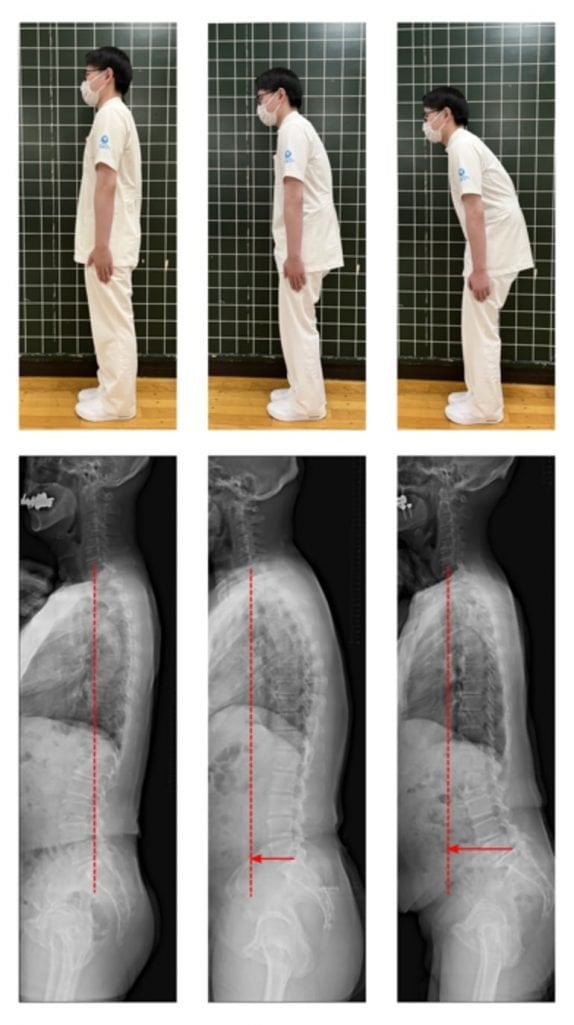Summary: An older person’s posture may give clues to hidden cognitive decline, a new study reports.
Source: Shinshu University
A mass survey of citizens aged 50 to 89 years examined whether cognitive decline could be detected by sagittal spinal balance measurement based on a radiological approach. Doctors from Shinshu University observed associations of sagittal vertical axis (SVA) anteriorization and higher age with lower cognitive function.
The sagittal vertical axis is the length of a horizontal line connecting the posterior superior sacral end plate to a vertical plumbline dropped from the centroid of the C7 vertebral body. The more the head and neck protrude in front of the pelvis when viewed from the side, (the greater the length) the more likely subjects are to show symptoms of mild cognitive decline.
In males, the SVA was associated with cognitive decline independently of age. In females, cognitive decline was more likely in cases of SVA that is equal or greater than 70mm regardless of age.
Mild cognitive impairment is cognitive complaints from the individual or associates and no dementia. Dementia, frail, and bedridden status maybe prevented by catching mild cognitive impairment at a reversible stage in communities where expensive special testing equipment or additional medical testing time is limited for the older population.
First author Hikaru Nishimura is an occupational therapist that research problems faced by the elderly from a rehabilitation perspective. Exercise training in older adults could prolong the extent of decline towards dementia or prevent it all together.
Corresponding author Doctor Shota Ikegami of Shinshu University states that poor posture is a manifestation of “frail” in the elderly. Hidden cognitive decline, a component of frail can be detected by posture screening.
Older adults in the town of Obuse, Nagano were examined for the mass survey and were found that in Japanese older adults, those who exhibited anteriorization of the spine was more likely to also have cognitive function decline.

Cognitive decline was reliably detected by combining age and the degree of spinal imbalance. Males with SVA ≥ 100 mm at any age, SVA ≥ 90 mm at ≥ 70 years, and SVA ≥ 70 mm at ≥ 80 years were likely to have cognitive decline, while females with SVA ≥ 70 mm at any age are likely to have cognitive decline.
The prefecture of Nagano boasts some of the highest health longevity in Japan. With this study and others, doctors hope to prevent future need for care through rehabilitation interventions for frail found during screenings.
Funding: This work was supported by a grant from the Japan Orthopaedics and Traumatology Research Foundation, Inc. [no. 339], Shinshu Public Utility Foundation for Promotion of Medical Sciences, Research Funding from the Japanese Society for Musculoskeletal Medicine, the Promotion Project of Education, Research, and Medical Care from Shinshu University Hospital, and The Nakatomi Foundation.
None of the above funding sources had any role in the design, execution, analysis, interpretation of data, or writing of the study.
About this posture and cognitive decline research news
Author: Hitomi Thompson
Source: Shinshu University
Contact: Hitomi Thompson – Shinshu University
Image: The image is in the public domain
Original Research: Open access.
“Detection of cognitive decline by spinal posture assessment in health exams of the general older population” by Hikaru Nishimura et al. Scientific Reports
Abstract
Detection of cognitive decline by spinal posture assessment in health exams of the general older population
The recent increase in the older adult population has led to a higher prevalence of cognitive impairment, which is often overlooked in routine health examinations. Citizens aged 50–89 years were targeted for this cohort survey by random sampling from the resident registry of a cooperating town in 2014. A total of 411 participants (202 male and 209 female) were enrolled.
We analyzed the distribution of cognitive function test scores as determined by Montreal Cognitive Assessment and Mini-Mental State Examination tests in each age (50’s, 60’s, 70’s and 80’s) and sex group to examine whether cognitive decline could be detected by sagittal spinal balance measurement based on a radiological approach.
Sagittal spinal balance was quantitatively measured as sagittal vertical axis (SVA). We observed significant associations for higher age and/or SVA anteriorization with lower cognitive function.
In males, spinal balance anteriorization was associated with cognitive decline independently of age, with combinations of age and SVA also making valid cognitive decline determinations; male cases of SVA ≥ 100 mm at any age, SVA ≥ 90 mm at ≥ 70 years, and SVA ≥ 70 mm at ≥ 80 years were all more likely to have cognitive decline than cases below those values. For females, cognitive decline was more likely in cases of SVA ≥ 70 mm, regardless of age.
Thus, spinal balance anteriorization can be regarded as an easily visible indicator of latent cognitive decline in community-dwelling older people.







